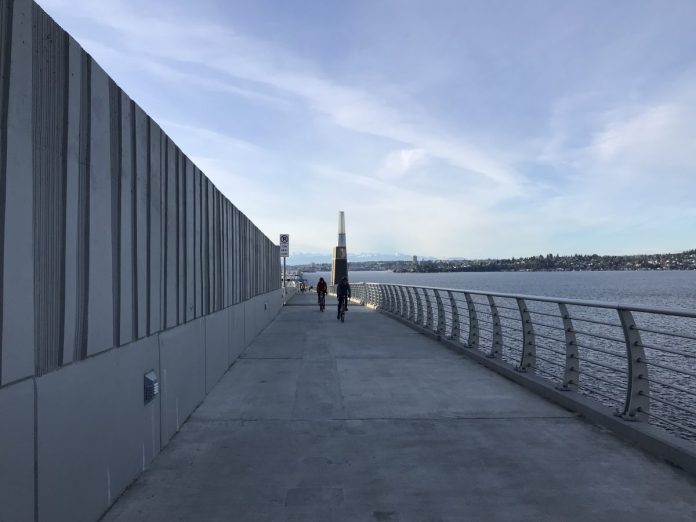The Washington State Department of Transportation (WSDOT) has been working on a statewide active transportation plan this year that could reshape the state’s highway paradigm. The preliminary analysis takes stock of existing state highway facilities. WSDOT hopes that this information will be useful in generating a conversation around how to better evaluate conditions from the perspective of people walking, biking, and rolling as well as what priorities people have for mobility investments and how the state can work to improve facilities in coordinated manner with local governments.
Assessment background
WSDOT says it wants to answer several big questions in the active transportation plan:
- “What enables people of all ages and abilities/disabilities to get from here to there safely?”
- “Where do people connect to transit, ferries, rail, and air?”
- “For both WSDOT facilities and important connections to local systems, what should we do first to work toward complete, comfortable connections for all?”
- “What facilities does WSDOT own and how well do these serve a safe, accessible, connected network?”
- “What do we do now in funding and policy, what are the results, and what needs to change?”
- “How do we track and report meaningful progress?”
These questions are incredibly vital to answer so that statewide transportation can move toward a more safe, equitable, sustainable, and multimodal system. With the preliminary data now available, it is clear that state transportation planners have their work cut out for them.
WSDOT has done some early analysis to determine the level of traffic stress a person experiences on its roadway assets where walking, rolling, and biking is allowed. This is shown through separate interactive map datasets: one for people walking and rolling, and another for people biking. Both interactive map datasets visually depict stress levels of roadways and intersections using a four-level rating system. Blue is least stressful while red is most stressful. The rating system itself is generated from data on traffic speed, road volumes, road width and number of travel lanes, and kind of facilities oriented to people walking and rolling.
The datasets are also informed by the location of a given asset, which can affect the rating. When an assets is located in a population center (i.e., cities and small towns), it appears on the map as a solid line. WSDOT says that these “places are expected to provide for the needs of more roadway users including younger and older people as well as those with disabilities, so they are held to a higher standard.” Meanwhile, assets located in rural areas (i.e., areas where there are few places to go) are denoted with a dashed line on the map. According to WSDOT, “those walking or biking in rural areas were assumed to be more confident travelers who would tolerate more challenging conditions (such as being near faster moving vehicles).”
WSDOT has cautioned that this data is preliminary, not entirely complete, and does not take into account condition factors that individuals may perceive when walking, rolling, or biking on any given stretch of road.
The state of walking, biking, and rolling on highways
Generally, the statewide picture is grim; nearly all places rank at a yellow and red level. This is consistent for both datasets, although biking conditions appear to be markedly worse. Perhaps as to be expected, areas outside of cities and towns are less stressful. This makes large swaths of Eastern Washington, Cascade Mountains, and Washington Coast stand out as less stress. But that is somewhat misleading given that the rankings tilt rural areas toward less desirable acceptable conditions for stress levels.
The following set of maps show the stress levels for walking and rolling at the state, regional, and local level.

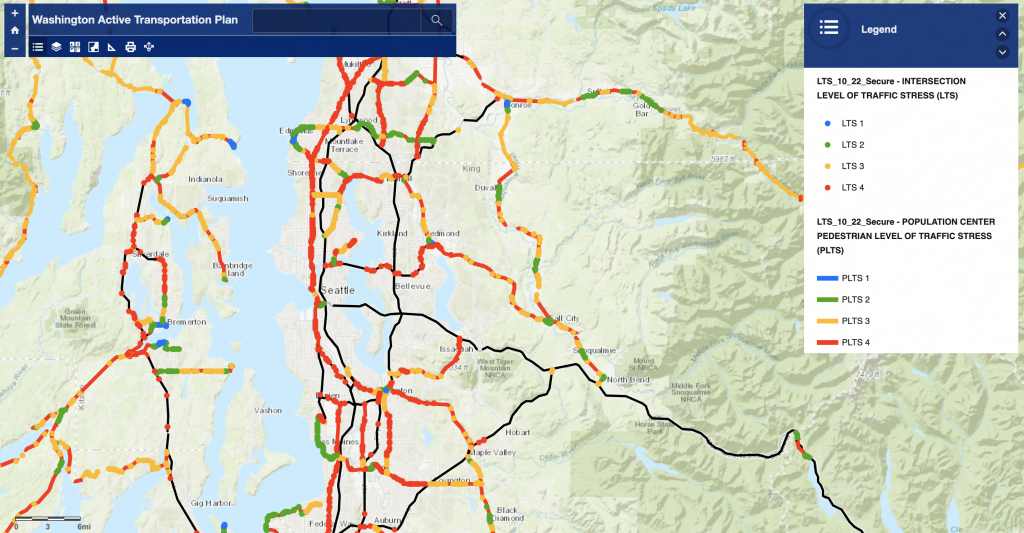
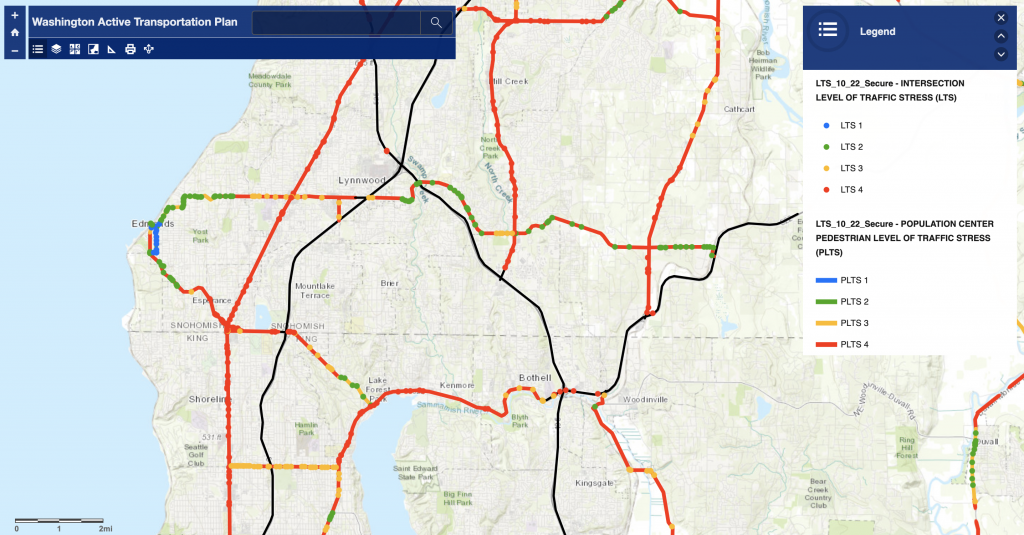
What is notable is that some elements of the Central Puget Sound appear pleasant. Edmonds, which has two state highways running through it, rates well for the stretch on 3rd Ave. That street is traffic calmed in the heart of the city center. Meanwhile, portions of the state highway on Filbert Rd (SR-524) east of I-405 also rate well, despite very high traffic volumes, narrow shoulders, and virtually no sidewalks. This should in fact rate poorly in data, so the mapping approach clearly could use quite a bit of refining.
The next set of maps show the stress levels for biking at the state, regional, and local level.

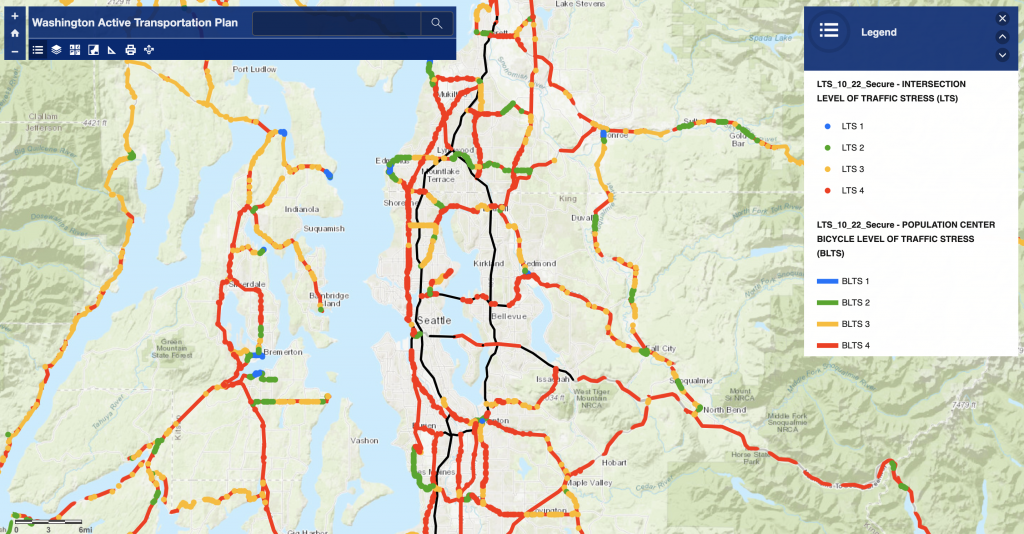
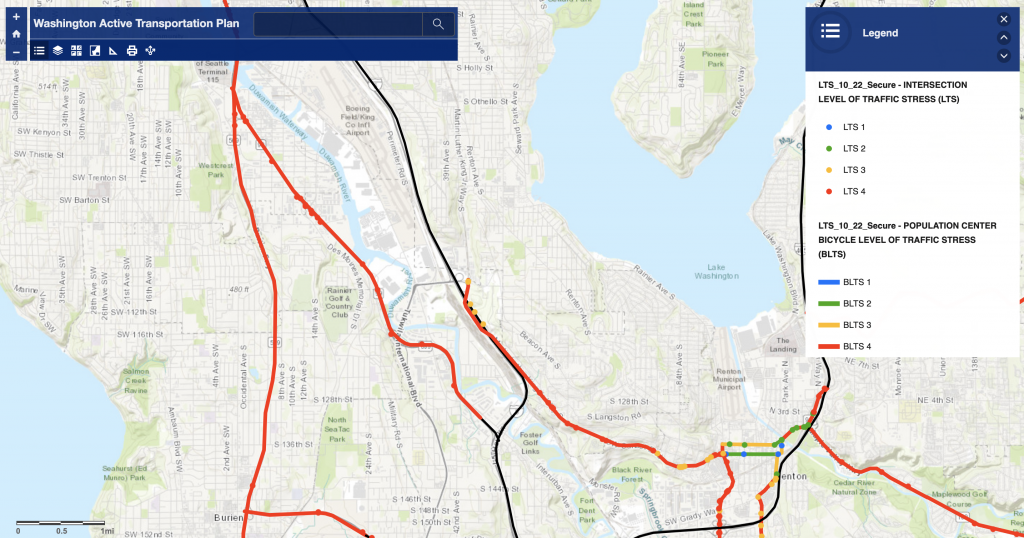
The ratings for biking facilities across the state are probably what most people biking would assume. It is bleak virtually everywhere with only places like downtowns in small cities and towns rating fairly stress-free. That really means very few blocks turn out to be pleasant places to bike on state highways. What is peculiar in the dataset, however, is that some facilities like the trails on the SR-520 and I-90 bridges indicate no data or that access is prohibited. That is an issue that WSDOT has acknowledged through the online open house disclaimers.
Opportunities in developing a plan, process, and outlook
There is ample low-hanging fruit for WSDOT to pick, at little cost, as the agency develops and implements an active transportation plan. The agency should consider internal reforms, such as updating standard plans with the needs of people walking, rolling, and biking in mind and ensuring staff respond to all opportunities to request developer contributions for right-of-way improvements, including sidewalks and bicycle lanes, on highway frontages under state control. The agency could also push for new state authority to require that all new development, regardless of project scope, in urban areas on state highways meet a minimum pedestrian and bike standard. Right now, the situation across the state often leaves no pedestrian and bicycle improvements on urban highways despite impacts from new development.
The next steps in developing the statewide active transportation plan involve a formal draft to be prepared over the course of the next month followed by consistency review with other modal plans and agency review in February. In March, WSDOT hopes to release the draft plan for public review and comment before a round of revisions. A final plan should be released in May.
In order to inform that process, WSDOT is seeking feedback through an online survey, which is open for public participation through December 15th. The survey primarily concerns itself with how people typically get around, obstacles to walking and biking, accessibility issues, and what changes would make walking, rolling, and biking easier and more desirable to do. WSDOT also is seeking feedback on the level of traffic stress approach.
The timing of this planning process is somewhat poignant though. With the specter of Initiative 976 (I-976) looming overhead, vital state transportation funding for walking, rolling, and biking projects face cuts. That could mean more than 65% in funding cuts in just the first year of the initiative’s life. Senator Steve Hobbs (D-Lake Stevens), chair of the Senate Transportation Committee, said that he wants to do the cuts regardless of what happens to I-976 in the courts, but that was before both a trial court and the state supreme court put a pause on I-976 implementation. The state legislature is set to go back into session in early January, which is when cuts or alternative funding methods could be determined. So what is the path forward in a state grappling with a road safety crisis, booming urban growth, and climate change?
Stephen is a professional urban planner in Puget Sound with a passion for sustainable, livable, and diverse cities. He is especially interested in how policies, regulations, and programs can promote positive outcomes for communities. With stints in great cities like Bellingham and Cork, Stephen currently lives in Seattle. He primarily covers land use and transportation issues and has been with The Urbanist since 2014.

